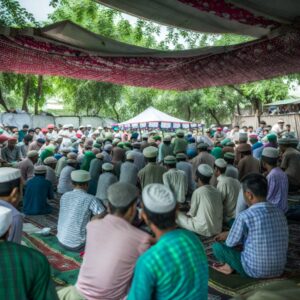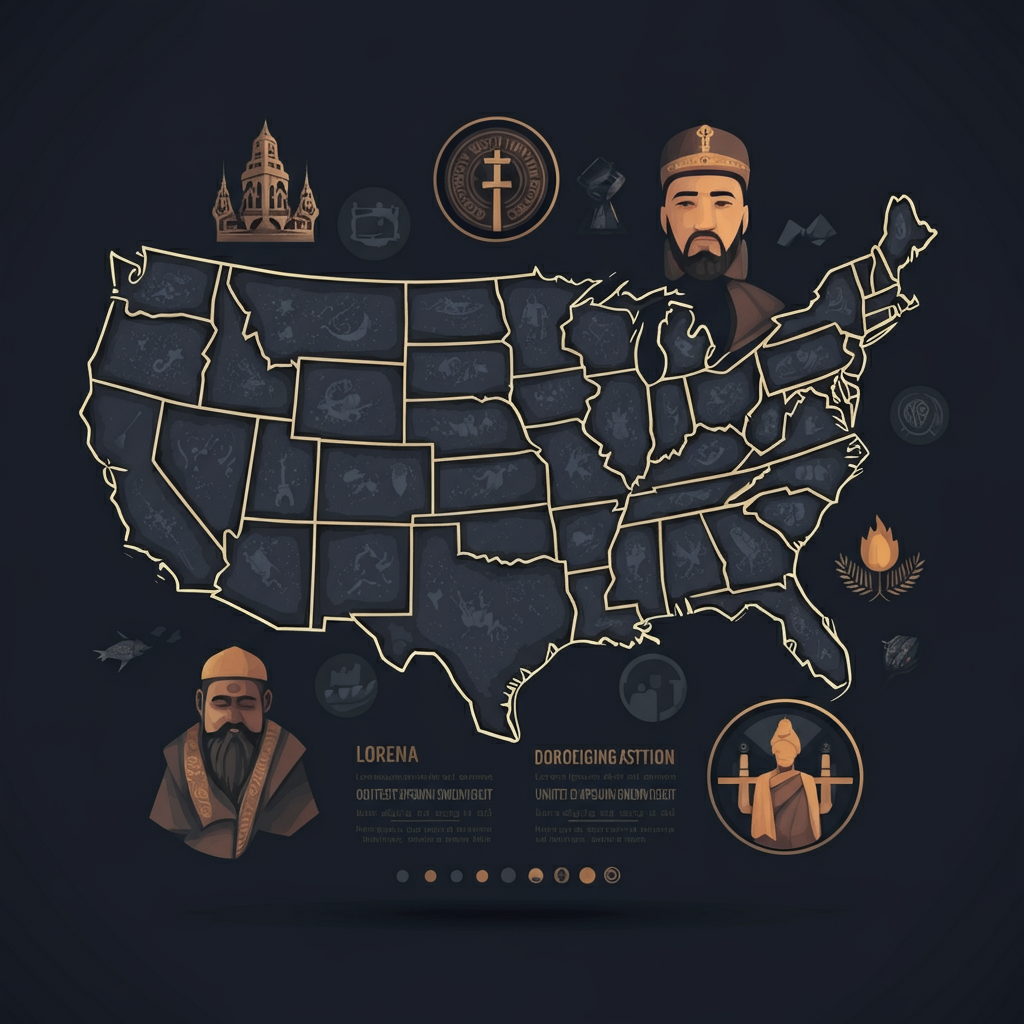The religious landscape in the United States has been evolving rapidly over the past few decades. Historically, Christianity has dominated American religion, but this is changing. Today, one of the most interesting trends is the emergence of new and rapidly growing religions. As diverse groups of immigrants bring their faiths into the country, and as younger generations seek new spiritual paths, we are witnessing a shift in religious affiliations and beliefs.
The fastest growing religion in the US has become a subject of intense interest for scholars, sociologists, and demographers. Understanding this shift requires a comprehensive look at social, political, and cultural factors. The fastest growing religions in the United States offer a fascinating glimpse into the changing spiritual landscape of the country. In this article, we will delve into these trends, analyze the factors behind the growth of certain religions, and explore how these shifts reflect broader societal changes.
The Fastest Growing Religion in the USA: Who Is It?
The Impact of Immigration on Religious Growth
The USA is home to one of the most diverse populations in the world, with immigrants from all corners of the globe bringing a variety of religious beliefs. This influx of people has significantly altered the country’s religious makeup, contributing to the rise of various religions. The fastest growing religion in the USA is often closely linked to immigration trends.
In recent years, Islam has emerged as one of the fastest growing religions in the United States. This growth is largely driven by immigration from Muslim-majority countries such as the Middle East, South Asia, and parts of Africa. Additionally, higher birth rates within Muslim communities contribute to the religion’s expansion.
At the same time, Hinduism has also experienced substantial growth, particularly due to the increasing number of Indian immigrants. This influx of people has led to a rise in the establishment of Hindu temples, community centers, and cultural events across the United States.
The fastest growing religions in USA are not just confined to these two examples, however. Buddhism, Sikhism, and other non-Christian religions are also gaining followers at unprecedented rates. This growth signals a shift in the religious identity of the nation, which has historically been dominated by Christianity.
Factors Driving the Growth
A Changing Cultural and Social Landscape
One of the main factors contributing to the rise of the fastest growing religion US is the broader social and cultural transformation taking place in the United States. Younger generations are increasingly disillusioned with traditional religious institutions and are seeking new ways to connect with spirituality. This has led to a rise in interest in religions that were not traditionally associated with the American mainstream.
For example, many young people are turning to Buddhism and Hinduism for their emphasis on meditation, mindfulness, and inner peace. These religions offer an alternative to the rigid structures of traditional Western religions. As these beliefs gain popularity, they contribute to the growth of the fastest growing religions in the United States.
The cultural emphasis on individualism and personal exploration is also a significant factor in the expansion of new religious movements. These movements tend to attract people who are looking for flexible, personal spiritual paths, rather than rigid doctrines.
The Role of Technology and the Internet
Another major factor behind the rise of the US fastest growing religion is the role of the internet and digital media in spreading religious ideas. Online communities, social media platforms, and digital content have allowed religious groups to reach larger audiences, often outside their immediate geographical areas. This has enabled religions such as Islam and Hinduism to expand beyond traditional immigrant communities and attract converts from different demographic backgrounds.
Media platforms like YouTube, podcasts, and websites have become key tools for religious leaders and followers to share their teachings. Virtual communities offer a space for individuals to explore new religious beliefs, participate in online discussions, and attend virtual worship services. As a result, the reach of the fastest growing religion in the United States has expanded far beyond the traditional methods of outreach.
The Fastest Growing Religions in the United States: A Closer Look
Islam: The Rising Faith in America
One of the most striking examples of the fastest growing religion in the USA is Islam. As the Muslim population continues to rise, the religion has become more visible and influential in American society. According to demographic studies, the Muslim population in the U.S. is expected to double in the next few decades.
The reasons for the rapid growth of Islam in the United States are multifaceted. One significant factor is the increasing number of Muslim immigrants, particularly from countries like Pakistan, India, Bangladesh, and various Middle Eastern nations. Many of these immigrants bring their families with them, contributing to the growing number of Muslim Americans.
Islam’s growth is also fueled by the religion’s appeal to younger generations. Islam’s emphasis on community, family, and charity resonates with many young people looking for a sense of purpose and connection. Furthermore, the rise of online communities and social media has played a crucial role in the spread of Islamic teachings and practices among American converts.
Hinduism: Expanding Its Reach in the USA
Another fastest growing religion US is Hinduism. Hinduism has deep historical roots in the United States, dating back to the 19th century. However, it has only been in recent decades that the religion has seen significant growth, primarily due to immigration from India and other South Asian countries.
The fastest growing religions in USA also include Hinduism, as it has expanded through the establishment of temples, cultural festivals, and spiritual centers across the country. Major cities like New York, Chicago, and San Francisco now have thriving Hindu communities. As these communities grow, they contribute to the spread of Hindu beliefs and practices, such as meditation, yoga, and vegetarianism.
The increased visibility of Hinduism in American popular culture, from the practice of yoga to the celebration of Diwali, has also helped raise awareness and interest in the religion. Many Americans, particularly in urban areas, are drawn to the peaceful, philosophical aspects of Hinduism, which focuses on the interconnectedness of all living beings.
The Future of Religion in the USA
A Changing Religious Landscape
The religious demographics of the United States are expected to continue evolving in the coming decades. As immigration continues to bring new religious traditions to the U.S., the fastest growing religion in the USA will likely shift in response to these demographic changes. The ongoing growth of Islam, Hinduism, and other religions, alongside the continued decline of Christianity, will reshape the religious landscape.
One of the key factors to watch will be the rise of religious “nones” — individuals who identify as atheist, agnostic, or unaffiliated with any religious tradition. This group is rapidly expanding, especially among younger Americans, and their numbers are expected to grow. While not a religion per se, the rise of religious non-affiliation may influence the growth of other religious movements, as many people turn to new spiritual practices in the absence of traditional religious identities.
As the fastest growing religions in the United States continue to emerge, it is crucial to understand the social, cultural, and political factors that contribute to their expansion. These religions are not only influencing the lives of those who practice them but also affecting broader American society in profound ways.
Pew Research Center:
The Pew Research Center is a nonpartisan think tank based in Washington, D.C., that conducts public opinion polling, demographic research, and social science research. It is widely known for its comprehensive studies on religion, politics, technology, and demographics. Pew’s research on religion in the United States and globally provides insights into shifting religious trends, such as the growth of non-Christian religions and the rise of religiously unaffiliated individuals. Through its thorough surveys and studies, the Pew Research Center plays a crucial role in analyzing how religion intersects with various aspects of society, shaping public policy and social understanding.
Religious Switching in USA:
Religious switching in the U.S. refers to the phenomenon where individuals change their religious affiliations, either converting to another faith or identifying as religiously unaffiliated. Research by the Pew Research Center indicates that this trend has become increasingly common, particularly among younger generations. Many people are leaving traditional religious denominations, such as Christianity, and turning to other faiths or adopting secular worldviews. This shift highlights the broader societal changes in the U.S., where personal spirituality often takes precedence over institutional affiliation. Religious switching has major implications for understanding the evolving religious composition of the country.
Hindu Population in USA:
The Hindu population in the USA has been steadily increasing, driven largely by immigration from India and other South Asian countries. According to the Pew Research Center, the number of Hindus in the U.S. has grown significantly in recent decades, with large communities now established in urban areas such as New York, California, and Texas. The Hindu population is expected to continue to grow due to higher fertility rates within the community and the influx of new immigrants. Hinduism’s influence in American society is also becoming more prominent, with Hindu temples, cultural events, and educational institutions gaining recognition and respect.
Jewish Populations in USA:
The Jewish population in the United States is one of the oldest and most established religious communities in the country. It has a rich cultural, religious, and historical presence, with the majority residing in urban areas such as New York City. Despite the challenges of assimilation and intermarriage, Jewish communities remain strong and vibrant. According to Pew Research Center, the Jewish population is estimated to be around 2% of the total U.S. population. While numbers have remained relatively stable, the community faces challenges related to religious identity and the preservation of traditions among younger generations.
Percentage Points of Region in USA:
The percentage points of religious affiliations in the United States reflect significant regional variations in religious practices and beliefs. For instance, the Bible Belt in the southern part of the country has a higher percentage of Evangelical Christians, while states like California, New York, and Illinois have more religiously diverse populations. The Pew Research Center has highlighted that the percentage points of various religious groups differ across regions, with some areas experiencing growth in non-Christian religions such as Islam, Hinduism, and Buddhism, while others continue to see a predominance of Christianity.
Fertility Rates in United States:
Fertility rates in the United States have been declining in recent years, with the average number of children born to women in the U.S. dropping below replacement levels. According to the Centers for Disease Control and Prevention (CDC), the fertility rate in the U.S. has fallen to historically low levels, with significant differences between various demographic groups. Immigrant populations, particularly from countries with higher birth rates, such as Muslim and Hispanic communities, contribute to the overall fertility rates in the country. The impact of fertility rates is also seen in how they influence the religious makeup of the U.S., particularly among immigrant populations.
Largest Muslim Population in 2025 in USA:
The largest Muslim population in the United States is projected to continue growing by 2025, driven by both immigration and higher birth rates. The U.S. has the largest Muslim population outside the Middle East, with the majority residing in urban areas such as New York, Chicago, and Los Angeles. According to Pew Research Center, the Muslim population is expected to increase significantly over the next few decades, largely due to continued immigration from Muslim-majority countries and higher fertility rates within the Muslim community. The largest Muslim population will continue to play a growing role in shaping America’s cultural, social, and religious landscape.
Global Religious Growth:
Global religious growth refers to the changing patterns of religious affiliation and the increasing diversity of beliefs around the world. According to the Pew Research Center, the global Muslim population is growing rapidly, while Christianity remains the world’s largest religion. Meanwhile, Hinduism and Buddhism are also seeing growth, particularly in Asia and the Pacific regions. Factors such as immigration, fertility rates, and religious conversions are contributing to this growth. The rise of the religiously unaffiliated population is another global trend, with secularism and non-religious beliefs gaining ground in parts of Europe and the Americas.
Latin America Religion Growth:
In Latin America, religion has traditionally been dominated by Catholicism, but recent years have seen notable shifts in religious affiliation. Evangelical Christianity is the fastest growing religion in many Latin American countries, according to the Pew Research Center. This rise in Evangelical populations has reshaped religious dynamics in countries such as Brazil, Mexico, and Argentina. The region has also seen growth in non-Christian religions, particularly among immigrants. Despite the decline in Catholicism, the religious landscape in Latin America remains deeply influential, with religious organizations playing a prominent role in society and politics.
Christian Populations in USA:
The Christian population in the United States has been experiencing gradual decline over the past few decades. According to Pew Research Center, Christianity remains the largest religion in the U.S., but the number of people identifying as Christians has decreased. This decline is particularly evident among younger generations, many of whom are opting to identify as religiously unaffiliated or embracing non-traditional spiritual beliefs. Despite this, Christianity continues to be a dominant force in American culture, with large communities of Evangelical Christians, Catholics, and mainline Protestants scattered across the country.
Religiously Unaffiliated Population:
The religiously unaffiliated population in the United States has been growing steadily, particularly among younger generations. According to Pew Research Center, a significant percentage of Americans now identify as atheist, agnostic, or “nothing in particular,” marking a departure from traditional religious affiliations. This trend, often referred to as the “rise of the nones,” reflects broader cultural and societal shifts toward secularism. The religiously unaffiliated group is expected to continue growing, particularly in urban areas and among younger, more educated Americans. This growth is reshaping the religious landscape of the U.S., leading to greater religious diversity and secular influence.
Asia Pacific Region:
The Asia Pacific region is home to a diverse array of religious beliefs, with some of the largest populations of Buddhists, Hindus, Muslims, and Christians in the world. The region has seen significant religious growth in recent decades, particularly in countries like India, Indonesia, and China. According to the Pew Research Center, the Asia Pacific region is expected to continue experiencing religious growth, especially among Muslims and Hindus. Additionally, the rise of Christianity in countries like China and South Korea indicates a changing religious dynamic in this region. The growth of religions in Asia Pacific will play a key role in shaping global religious trends.
Saharan Africa Religion:
In Saharan Africa, religion is experiencing significant transformation, with Islam and Christianity both seeing rapid growth. According to Pew Research Center, the region is one of the most religiously diverse and vibrant in the world. The Muslim population is expanding quickly in the northern and western parts of Africa, while Christianity is growing in sub-Saharan Africa, particularly in countries like Nigeria and Ethiopia. Fertility rates are also higher in Africa, which contributes to the growth of religious populations. The region’s religious landscape continues to evolve, with younger generations shaping the future of religion across the continent.
A Dynamic Future for Religion in the USA
The fastest growing religion in the USA is an ever-evolving topic that reflects the broader shifts taking place in American society. As immigration, technology, and changing cultural norms continue to shape the religious landscape, the United States will likely see even more religious diversity and growth in the coming decades. Islam, Hinduism, and other non-Christian religions are poised to become even more prominent as they continue to attract new followers.
At the same time, the rise of secularism and non-affiliation presents a unique challenge to traditional religious institutions. As the US fastest growing religion continues to evolve, it will be important to understand the underlying factors that drive these changes, and how these trends will impact the future of religious practice in the United States.
In conclusion, the fastest growing religions in the United States are changing the way we think about spirituality and religious identity. These shifts are not just statistical; they reflect deeper cultural, social, and political currents that are reshaping American society. Whether you are studying these trends for academic reasons, or simply seeking to understand the religious landscape, the rise of new religions in the United States is a fascinating and important subject that deserves attention.






